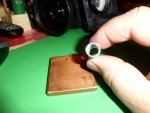I cut the back out of the aluminum can/module back, put a little paste on the back of the diode and pasted on a hand made copper plug cut from 1/4 inch stock with a hole big enough for my wires that are insulated with heat shrink tubing, covered the plug in paste, slipped over the aluminum can and filled it all the way up from the open back using little sticks to pack the paste in around the wires, I also wiped paste around the inside of the can before sliding it over the plug and screwing it on, I let is sit for a few hours until it was firm.
The paste I use is not expensive yet it works well, it comes out like thick toothpaste and dries to firm/rubbery clay.
I do not recommend this over the full copper back half, I prefer the solid copper back half, I just didn't want to un solder my diode from the too large for the copper back size wire I used.
The truth is I screwed up by not checking the solid copper back half hole diameter before attaching my wire, that's usually not an issue and I almost always drill out the back of my cans and paste in plugs.
But now that the copper backs are available I plan to use those or square box mounts that contact the diode back.





